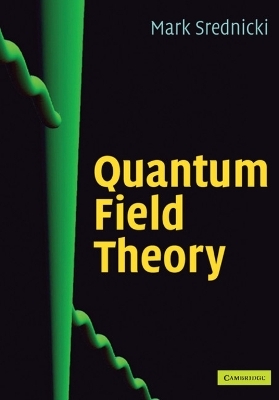
Quantum Field Theory
Cambridge University Press (Verlag)
978-0-521-86449-7 (ISBN)
Quantum field theory is the basic mathematical framework that is used to describe elementary particles. This textbook provides a complete and essential introduction to the subject. Assuming only an undergraduate knowledge of quantum mechanics and special relativity, this book is ideal for graduate students beginning the study of elementary particles. The step-by-step presentation begins with basic concepts illustrated by simple examples, and proceeds through historically important results to thorough treatments of modern topics such as the renormalization group, spinor-helicity methods for quark and gluon scattering, magnetic monopoles, instantons, supersymmetry, and the unification of forces. The book is written in a modular format, with each chapter as self-contained as possible, and with the necessary prerequisite material clearly identified. It is based on a year-long course given by the author and contains extensive problems, with password protected solutions available to lecturers at www.cambridge.org/9780521864497.
Mark Srednicki is Professor of Physics at the University of California, Santa Barbara. He gained his undergraduate degree from Cornell University in 1977, and received a PhD from Stanford University in 1980. Professor Srednicki has held postdoctoral positions at Princeton University and the European Organization for Nuclear Research (CERN).
Preface for students; Preface for instructors; Acknowledgements; Part I. Spin Zero: 1. Attempts at relativistic quantum mechanics; 2. Lorentz invariance; 3. Canonical quantization of scalar fields; 4. The spin-statistics theorem; 5. The LSZ reduction formula; 6. Path integrals in quantum mechanics; 7. The path integral for the harmonic oscillator; 8. The path integral for free field theory; 9. The path integral for interacting field theory; 10. Scattering amplitudes and the Feynman rules; 11. Cross sections and decay rates; 12. Dimensional analysis with ?=c=1; 13. The Lehmann-Källén form; 14. Loop corrections to the propagator; 15. The one-loop correction in Lehmann-Källén form; 16. Loop corrections to the vertex; 17. Other 1PI vertices; 18. Higher-order corrections and renormalizability; 19. Perturbation theory to all orders; 20. Two-particle elastic scattering at one loop; 21. The quantum action; 22. Continuous symmetries and conserved currents; 23. Discrete symmetries: P, T, C, and Z; 24. Nonabelian symmetries; 25. Unstable particles and resonances; 26. Infrared divergences; 27. Other renormalization schemes; 28. The renormalization group; 29. Effective field theory; 30. Spontaneous symmetry breaking; 31. Broken symmetry and loop corrections; 32. Spontaneous breaking of continuous symmetries; Part II. Spin One Half: 33. Representations of the Lorentz Group; 34. Left- and right-handed spinor fields; 35. Manipulating spinor indices; 36. Lagrangians for spinor fields; 37. Canonical quantization of spinor fields I; 38. Spinor technology; 39. Canonical quantization of spinor fields II; 40. Parity, time reversal, and charge conjugation; 41. LSZ reduction for spin-one-half particles; 42. The free fermion propagator; 43. The path integral for fermion fields; 44. Formal development of fermionic path integrals; 45. The Feynman rules for Dirac fields; 46. Spin sums; 47. Gamma matrix technology; 48. Spin-averaged cross sections; 49. The Feynman rules for majorana fields; 50. Massless particles and spinor helicity; 51. Loop corrections in Yukawa theory; 52. Beta functions in Yukawa theory; 53. Functional determinants; Part III. Spin One: 54. Maxwell's equations; 55. Electrodynamics in coulomb gauge; 56. LSZ reduction for photons; 57. The path integral for photons; 58. Spinor electrodynamics; 59. Scattering in spinor electrodynamics; 60. Spinor helicity for spinor electrodynamics; 61. Scalar electrodynamics; 62. Loop corrections in spinor electrodynamics; 63. The vertex function in spinor electrodynamics; 64. The magnetic moment of the electron; 65. Loop corrections in scalar electrodynamics; 66. Beta functions in quantum electrodynamics; 67. Ward identities in quantum electrodynamics I; 68. Ward identities in quantum electrodynamics II; 69. Nonabelian gauge theory; 70. Group representations; 71. The path integral for nonabelian gauge theory; 72. The Feynman rules for nonabelian gauge theory; 73. The beta function for nonabelian gauge theory; 74. BRST symmetry; 75. Chiral gauge theories and anomalies; 76. Anomalies in global symmetries; 77. Anomalies and the path integral for fermions; 78. Background field gauge; 79. Gervais-Neveu gauge; 80. The Feynman rules for N x N matrix fields; 81. Scattering in quantum chromodynamics; 82. Wilson loops, lattice theory, and confinement; 83. Chiral symmetry breaking; 84. Spontaneous breaking of gauge symmetries; 85. Spontaneously broken abelian gauge theory; 86. Spontaneously broken nonabelian gauge theory; 87. The standard model: Gauge and Higgs sector; 88. The standard model: Lepton sector; 89. The standard model: Quark sector; 90. Electroweak interactions of hadrons; 91. Neutrino masses; 92. Solitons and monopoles; 93. Instantons and theta vacua; 94. Quarks and theta vacua; 95. Supersymmetry; 96. The minimal supersymmetric standard model; 97. Grand unification; Bibliography.
| Erscheint lt. Verlag | 25.1.2007 |
|---|---|
| Zusatzinfo | Worked examples or Exercises; 3 Halftones, unspecified; 87 Line drawings, unspecified |
| Verlagsort | Cambridge |
| Sprache | englisch |
| Maße | 158 x 255 mm |
| Gewicht | 1450 g |
| Themenwelt | Naturwissenschaften ► Physik / Astronomie ► Quantenphysik |
| Naturwissenschaften ► Physik / Astronomie ► Theoretische Physik | |
| ISBN-10 | 0-521-86449-6 / 0521864496 |
| ISBN-13 | 978-0-521-86449-7 / 9780521864497 |
| Zustand | Neuware |
| Haben Sie eine Frage zum Produkt? |
aus dem Bereich
